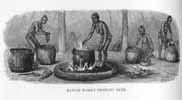Nguni Shields

An Nguni shield in the Pitt Rivers collection
Please note that the Pitt Rivers Museum uses the term 'Nguni' for those objects (collected and donated many years ago) whose provenance was given, on donation, as nothing more specific than 'southern Africa, Kaffir' ('Kaffir' being a name referring to the group of people). Quite a large number of collections obtained early in the Museum's history (including the founding collection of Pitt Rivers himself) contained objects assigned to the 'Kaffir'. This was a general term employed during the nineteenth century, for the group of peoples now called Nguni. It is now recognised to be a derogatory and unusable term. This is but one of many instances of a historical term now considered unacceptable for general use, but which was in the past and in then contemporary mores, completely acceptable. The Museum fully approves the more culturally sensitive and accurate current terms, and employs these terms in all contemporary cataloguing. Nevertheless, it does not feel that the historical record should be censored. Readers are asked to bear this in mind when reviewing some aspects of the historical records given as part of the project.
Nguni/Zulu shields: Extract from Plaschke and Zirngibl, African Shields
pp 20 - 21
... Unlike South Africa's barren interior, both the Cape Province and the climatically friendlier regions in the east offer their inhabitants sufficient room for grazing their livestock. Today South Africa is the homeland of large ethnic groups of very varying extraction, broken into four large language groups: Nguni (Ndebele, Swazi, Xhosa and Zulu), Tswana (Pedi and southern Sotho), Venda and Shangaan Tsonga. Light throwing shields, mallet clubs and battle axes formed the most important offensive weapons of these tribes whereas, oval, man-high shields cut out of coarse, partly tanned cowhide were widely used defensive weapons. A recurrent and striking characteristic of these shields were the interwoven hairy strips of differently coloured hide on both halves, drawn through a row of horizontal slits. These slits achieved not only a decorative effect but also stabilized the middle. A sturdy pole, often decoratively covered on top with a piece of hide, was pulled through the strips, thus fastening it tightly to the surface. Its user enjoyed great agility since it was held with only the thumb and fingertips.
All shields sharing the above mentioned traits were universally known as Zulu shields.
In the annals of South African history it is written that the Zulu acquired fame through the numerous campaigns of their conqueror king CHAKA, who spread fear and terror in the first quarter of the nineteenth century. Considered to have been a superb military leader, he armed and then organized tens of thousands of his subjects into a militarily well-trained and professional army. Chaka himself developed the weapons of his warriors, consisting of a short thrusting spear and a wise, pronouncedly oval shield. In contrast to the then prevailing style of African warfare, shields were used by him as a tactical weapon in a way reminiscent of the ancient Greeks: when attacking, warriors formed closed ranks behind the large shields, thus providing themselves with optimal protection. In order to identify regiments, the frontside of the shields were painted in the same colors as the uniforms of the warriors. Chaka's favorite regiment, together with the older, experienced fighters, wore white, while the younger were in black. In just a few years, Chaka's armies conquered huge areas and devasted [sic - devastated] large sections of South Africa. These campaigns were continued by following generations: One successor of Chaka defeated the British in a bloody battle at Isandhlwana as late as 1879. A few months later, however, the Zulu armies met their end in a decisive defeat at Ulundi at the hands of the same opponent.
Even today, the once-proud and martial Zulu still love to mimic war in their dances for the tourists by carrying dance shields known as trau, symbolizing their warlike past.